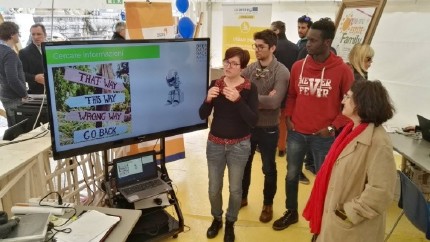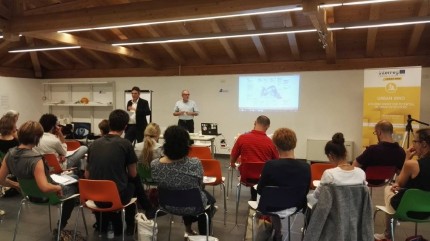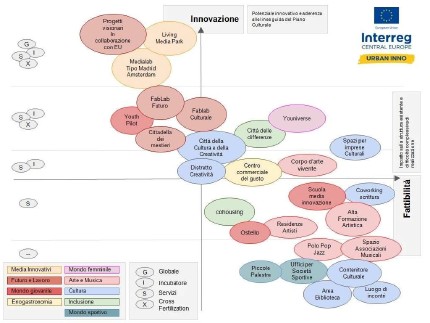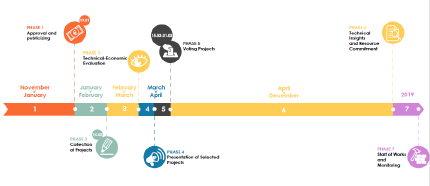TRENTO (Trentino) Pilot
Smart City And Smart Users For An Innovative Governance
Thematic field: GOVE - Government and public sector
PILOT DESCRIPTION
The Trento URBAN INNO pilot action has experimented the adoption of participative methods mainly inside the Trento Urban area, ensuring a direct involvement of the citizens. The main innovation points experimented:
How to propagate social and urban social/governmental issues to the government in an innovative way (‘smart’) with both participative methods and specific supporting ICT tools and use social media.
Improve the administrative action involving citizens in a participatory and sustainable way in an Open Government scenario.
Systematize the information/data and experiences gathered in order to develop the participatory process on important data, maps, statistics and historical memories for the citizens themselves.
Improve results communication through use of data display techniques and storytelling.
Trento Pilot will also push citizen participation and empowerment with specific activities aimed to the adoption of ICT tools and digital services provided by the Public Administration, not only online services but also online citizen engagement services and social media.
The activity of the Trento pilot has been coordinated with the overall wider Smart City Trento initiative that is involving all the Trentino innovation actors and innovation stakeholders.
THE ROLE OF END-USERS IN PILOT DEVELOPMENT
The pilot has involved citizens, cooperatives and other local actors interested in the adoption of participatory methods and digital empowerment, starting from a specific city area, District 11, going upward to the city level, up to Riva del Garda municipality for the Participatory Budget experience
The pilot directly involved
- The Polo Sociale S.Giuseppe-S.Chiara-Ravina-Romagnano in the design and implementation of a Youth working group with 7 different representatives of civil society to define what the needs
- The Trento Municipality for the definition of the Santa Chiara UrbanLab participatory process with more than 20 civil society representatives in the Design Thinking process that delivered several requirements for the design of the new urban city center.
- Worked directly with the Speck&Tech association in the organization of the 2 hackathons made in Trento, that also involved several local actors and produced several examples of innovative digital services
- Also worked with the Riva del Garda associations to gather direct feedback about the participatory budget
MAIN STAKEHOLDERS INVOLVED
- Comune di Trento - District 11 – San Giuseppe-Santa Chiara
- Comune di Trento – Servizio Cultura, Turismo e Politiche Giovanili
- Comune di Riva del Garda
- Trentino Digitale - Trentino as Lab Living Lab
- Trentino Digitale – Progetto collaborazione territoriale ICT
As observers:
- Autorità Provinciale per la Partecipazione
- Hub Innovazione Trentino
- Progetto Opendata del Trentino
PERSPECTIVES
About Hackathons
The Hackathon (also referred as Design Sprints or Project in a Day) events were very successful and achieved goals that exceeded expectations, not only for the numerous prototypes developed from the bottom, but in particular for the motivational effect created around the final event, with a sharing of objectives, a sense of community and a simple contagious amusement between the parties that have enormous results on confidence and trust between the parties. Particularly in the case of people who have no experience with this kind of events.
The prototypes made, although with little time available, were of excellent quality and in most cases functional, obviously with basic functionality, but very close to the real service, at least as necessary to be able to gather very useful feedback from both stakeholders from customers.
The realization demonstrated how it is possible to realize in an easy way, thanks to free tools such as Slack.com and GitHub.com , to increase the impact of local events (therefore of great social impact on the community through a physical and pleasant contact) not only to have a community wider, but also to create a “participative momentum” that stimulates creativity and local participation (being part of a bigger thing
About Design Thinking process with citizens
The participatory experiment has been made. Bigger activity for the S.Chiara Urban Lab, less just an experiment for the participatory process with S.Chiara young citizens.
The result of the S.Chiara Urban Lab participatory experiment it is very different from the experience with the hacks made with young people, stakeholders and SMEs. In this case, the target group has been much less flexible and freely speaking, although it talks about art and artists, it was not so open to discussion, it took an additional effort to break the ice in the room.
Probably challenge faced by the process, about urban development and the development of a strategy on urban cultural development with the support of the public contribution, is not a new theme and it is too much historically focused on the question “How much public money is there for me?” instead to focus how anyone could contribute to improve the effectiveness of the spending, connecting single projects, creating a dynamical exchange between the parts involved.
Moreover, in this kind of situation, the added value that can be given by the use of ICT technologies is limited, and it helps to share better information collected, but the main interaction remained inside the physical space and so it takes some effort that could not be reduced.
Participatory Budget main points
- The importance of precisely defining the "object" of the PB, that is the scope of proposition of the citizens with respect to the use of public resources, also in order to collect proposals that are more defined from the design point of view. In this regard, the hypotheses can be varied and include, among other possibilities, both the choice of specific themes diversified from year to year as well as the possibility of focusing the participation only on some territorial areas chosen within the municipal territory according to a principle of rotation;
- The opportunity to integrate the activities of the PB with those of public presentation of the institution's budget, in order to enhance them both within the same sense frame referred to the involvement of citizens in the decisions to use the institution's resources and to promote an informed participation with results of greater value and quality; this would help the growth of a shared culture that could over time lead the rivana community to experiment with PB even according to broader models;
- The need to enhance the hybridization between on-line and presence-based participation, in order to foster an in-depth collaborative dialogue on the needs and needs of the community, starting from different instances and preliminary to the presentation phase of the proposals, in order to direct the use of public resources on priorities defined collectively rather than on the mere presentation of individual proposals that do not automatically respond to common needs and / or priorities.

Chatbot (hackathon) presentation at the Trento Smart City Week 2018

Use of Design thinking with citizens is a challenge

Clustering citizens proposal in possible solutions

The participatory budget timeline in Riva del Garda
MORE ON TRENTO PILOT:
Start of Testing Participatory Methods – Listening to Youth
S.Chiara Cultural Incubator Co-Design kick-off
Open Data Hackabot Trentino 2018 #ODHB2018
Trento PILOT: Participatory innovation exploit
Trentino pilot: Evaluation of RivaPartecipa 2018
Trento PILOT: Participatory innovation exploit with provincial service provider in-house companies
Trento pilot: Participatory methods experience at primary school
